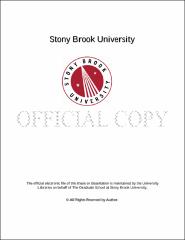| dc.identifier.uri | http://hdl.handle.net/11401/76915 | |
| dc.description.sponsorship | This work is sponsored by the Stony Brook University Graduate School in compliance with the requirements for completion of degree. | en_US |
| dc.format | Monograph | |
| dc.format.medium | Electronic Resource | en_US |
| dc.language.iso | en_US | |
| dc.publisher | The Graduate School, Stony Brook University: Stony Brook, NY. | |
| dc.type | Thesis | |
| dcterms.abstract | The use of cyclodextrins have shown promise to exchange lipids of model membranes in various conditions. Several types of cyclodextrins have been shown to exchange lipids in different conditions. In this study, we used Methyl-alpha cyclodextrin (MαCD) to facilitate lipid exchange between donor multilamellar vesicles (MLVs) containing brain SM and large unilamellar vesicle acceptors (LUVs) composed of POPE, POPS and cholesterol. This technique is just one of several exploring the use of cyclodextrins to manipulate artificial membranes in order to obtain asymmetry. Overview of other studies involving other types of cyclodextrin are also discussed to explain what is known about cyclodextrin-lipid interactions. Mastery of the utilization of these types of molecules can have the potential to significantly impact the way we carry out future membrane studies. With more insight, cell membranes we find in nature can be replicated and tested on in laboratory settings to further our understanding of the membrane bilayer. | |
| dcterms.abstract | The use of cyclodextrins have shown promise to exchange lipids of model membranes in various conditions. Several types of cyclodextrins have been shown to exchange lipids in different conditions. In this study, we used Methyl-alpha cyclodextrin (MαCD) to facilitate lipid exchange between donor multilamellar vesicles (MLVs) containing brain SM and large unilamellar vesicle acceptors (LUVs) composed of POPE, POPS and cholesterol. This technique is just one of several exploring the use of cyclodextrins to manipulate artificial membranes in order to obtain asymmetry. Overview of other studies involving other types of cyclodextrin are also discussed to explain what is known about cyclodextrin-lipid interactions. Mastery of the utilization of these types of molecules can have the potential to significantly impact the way we carry out future membrane studies. With more insight, cell membranes we find in nature can be replicated and tested on in laboratory settings to further our understanding of the membrane bilayer. | |
| dcterms.available | 2017-09-20T16:51:26Z | |
| dcterms.contributor | London, Erwin | en_US |
| dcterms.contributor | Brown, Deborah A | en_US |
| dcterms.creator | Greenstein, Brad | |
| dcterms.dateAccepted | 2017-09-20T16:51:26Z | |
| dcterms.dateSubmitted | 2017-09-20T16:51:26Z | |
| dcterms.description | Department of Biochemistry and Cell Biology. | en_US |
| dcterms.extent | 36 pg. | en_US |
| dcterms.format | Monograph | |
| dcterms.format | Application/PDF | en_US |
| dcterms.identifier | http://hdl.handle.net/11401/76915 | |
| dcterms.issued | 2015-12-01 | |
| dcterms.language | en_US | |
| dcterms.provenance | Made available in DSpace on 2017-09-20T16:51:26Z (GMT). No. of bitstreams: 1
Greenstein_grad.sunysb_0771M_12602.pdf: 449387 bytes, checksum: c6be4d20266d2a402cf931a1bc2a23ff (MD5)
Previous issue date: 1 | en |
| dcterms.publisher | The Graduate School, Stony Brook University: Stony Brook, NY. | |
| dcterms.subject | Biochemistry | |
| dcterms.subject | Asymmetry, Cyclodextrin, Lipid exchange, Membranes | |
| dcterms.title | Cyclodextrins as lipid exchange mediators to synthesize artificial asymmetric model membranes | |
| dcterms.type | Thesis | |

